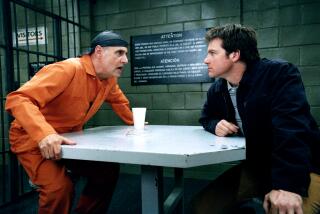Honoring a match made in medicine
- Share via
“Something the Lord Made” is a splendid docudramatic retelling of the intertwined lives and careers of Dr. Alfred Blalock (Alan Rickman) and his longtime technician and research assistant, Vivien Thomas (Mos Def), and their pioneering work in heart surgery in the 1930s and ‘40s. The film pulls off an inspirational hat trick: It’s at once the story of a medical breakthrough (celebrating its 60th anniversary this year), of honor belatedly bestowed and of a friendship that defied prejudicial convention. Sick babies are cured, overdue awards bestowed, deep feelings shyly expressed. You may weep.
It is one of the points of the film (premiering Sunday at 9 on HBO) that Thomas, as a black man in a segregated society, was only belatedly recognized for his contributions, but you have quite possibly not heard of Dr. Blalock, either, or of the tetralogy of Fallot, the condition whose groundbreaking treatment much of this film concerns. (You may know it by its nickname, “blue baby” syndrome -- a congenital deformation of the heart that robs the lungs of oxygen.) This is to the movie’s advantage, it being a biopictorial rule of thumb that the less the viewer knows the better.
For the record:
12:00 a.m. June 4, 2004 For The Record
Los Angeles Times Friday June 04, 2004 Home Edition Main News Part A Page 2 National Desk 1 inches; 58 words Type of Material: Correction
“Something the Lord Made” -- A review of HBO’s “Something the Lord Made” in the May 28 Calendar section said the movie’s script followed the lines of a PBS documentary, “Partners of the Heart.” Both the documentary and the movie were based in part on a 1989 Washingtonian magazine article, “Like Something the Lord Made,” by Katie McCabe.
Thomas was a 19-year-old Nashville carpenter whose dreams of medical school disappeared into the black hole of the Depression; he found himself as an odd-jobs lab assistant at Vanderbilt University Hospital under Blalock, who quickly recognized his talent and initiative and trained him as a surgical technician. For more than 30 years, they remained professionally inseparable; when Blalock became head of surgery at Johns Hopkins in Baltimore, it was on the condition that Thomas come with him. Thomas ran experiments, invented new surgical equipment and procedures, and, finally, in the “blue baby” operations, stood by Blalock’s shoulder while he operated, giving him advice and guidance.
The film doesn’t tell a story so much as paint a picture, but it is dramatic and even exciting, and the protagonists bump up against history in ways that illuminate both their characters and the society that made them (and which to a great, though not superhuman extent, they rose above or managed to ignore). It’s a time that seems both near and far, not only in matters of race relations, but in medical practice -- heart surgery was thought impossible before the ‘40s. “We are going to challenge this ancient doctrinal myth,” Blalock tells his colleagues.
And while the film doesn’t specifically draw parallels between scientific and social progress, they are there for you to consider. (Thomas’ achievements were acknowledged within his lifetime, fortunately, with an honorary doctorate from Johns Hopkins, where he became an instructor in surgery and where his portrait now hangs along with Blalock’s.)
Directed with a light hand by Joseph Sargent, who also made HBO’s “A Lesson Before Dying” and “Miss Evers’ Boys” -- Sargent seems to be the network’s go-to guy for African American period pieces -- the film is a lesson in modulated tone. Though it packs a lot into two hours, within each scene the pacing is quiet and slow, so that it’s enough for a character to raise his voice or widen an eye or move a little faster to create drama. When Blalock says, “Helen, I want to see all your diagnostic notes,” with the music gently swelling below, it feels like John Wayne strapping on the six guns.
There is no fancy camerawork, no pace-quickening edits; the score is mostly well-behaved. While the film is not entirely free of obvious “movie moments,” they are relatively few, or executed with natural carelessness. The facts are compelling enough; they don’t need help.
The facts, in fact, have already spoken for themselves: The script (by Peter Silverman, of “Hill Street Blues” and “Harlan County War”) pretty much follows the lines of last year’s PBS documentary “Partners of the Heart,” whose director, Andrea Kalin, was a consultant on the present film. Though events have been telescoped or switched in time for dramatic effect and narrative arc, nothing of substance has been invented. (Though Dr. Helen Taussig, who first suggested a surgical response to the tetralogy of Fallot, and is here played by Mary Stuart Masterson with a funny haircut and a jumbo antique hearing aid, perhaps does not quite get as much credit as she should.)
Rickman plays Georgia native Blalock with a touch of the Southern aristocrat, balancing the doctor’s hauteur and temper with passages of sympathy or delight. (There is a lovely throwaway moment when he takes the hose from a respirator Thomas has just built and blows air over his own face.) As Thomas, Mos Def -- best known as a recording artist, but an actor since his teens, including a regular stint on “The Cosby Mysteries” -- doesn’t possess Rickman’s expressive palette, but he has a quiet authority and more than holds his own.
Kyra Sedgwick and Gabrielle Union play Mrs. Blalock and Mrs. Thomas; Charles Dutton is hugely patriarchal as Vivien’s father.
There are scenes involving experimentation on animals, sensitive viewers may want to know, and a little bit of blood.
*
‘Something the Lord Made’
Where: HBO
When: Premieres 9-11 p.m. Sunday
Rating: The network has rated the film TV-PG (may not be suitable for young children)
Alan Rickman...Alfred Blalock
Mos Def...Vivien Thomas
Gabrielle Union...Clara Thomas
Kyra Sedgwick...Mary Blalock
Mary Stuart Masterson...Helen Taussig
Executive producers, Robert W. Cort, David Madden, Eric Hetzel. Director, Joseph Sargent. Writer, Peter Silverman.
More to Read
Only good movies
Get the Indie Focus newsletter, Mark Olsen's weekly guide to the world of cinema.
You may occasionally receive promotional content from the Los Angeles Times.











